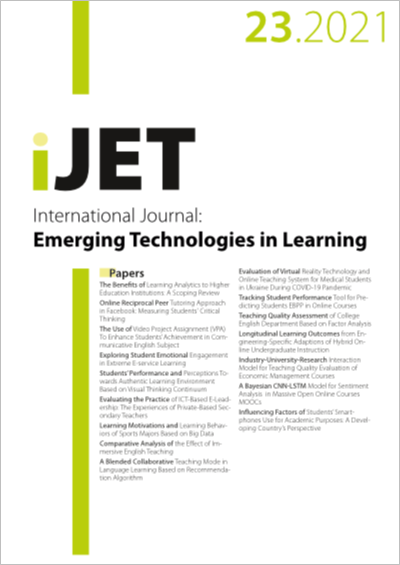Influencing Factors of Students’ Smartphones Use for Academic Purposes: A Developing Country’s Perspective
DOI:
https://doi.org/10.3991/ijet.v16i23.26675Keywords:
Smartphone Use, Academic Purpose, Learning, UTAUT 2Abstract
There is evidence that majority of students in many African countries own and use smartphones. Due to their portability and the many functions, they are used to perform, smartphones have virtually become a necessity. In education, it is known to facilitate communication and knowledge sharing among students. Yet, many students use smartphones for entertainment purposes. Worst of all, research that investigates the factors that influence students’ use of smartphones for learning are scarce particularly, in many African countries. Therefore, this study examines the influencing factors of smartphone use for academic purposes. It deviates from the few existing studies that have predominantly drawn samples from tertiary students of developed countries. The study presented a research model founded on UTAUT 2. Responses were gathered from 708 Ghanaian high school students using a questionnaire. Based on these responses, Partial Least Square Structural Equation Modelling was used to validate the model. The results confirmed that Effort Expectancy, Facilitating Conditions and Social Influence have significant influence on Hedonic Motivation and Perceived Usefulness. Similarly, Habit and Price Value mediated the effects of Hedonic Motivation and Perceived Usefulness on Behavioural Intention and Use Behaviour. The findings suggest that, educational institutions must provide the necessary support conditions for students to use smartphones for learning.
Downloads
Published
2021-12-08
How to Cite
Adu Gyamfi, S. (2021). Influencing Factors of Students’ Smartphones Use for Academic Purposes: A Developing Country’s Perspective. International Journal of Emerging Technologies in Learning (iJET), 16(23), pp. 233–246. https://doi.org/10.3991/ijet.v16i23.26675
Issue
Section
Papers
License
Copyright (c) 2021 Samuel Adu Gyamfi

This work is licensed under a Creative Commons Attribution 4.0 International License.


